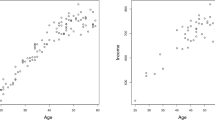Abstract
National data show a continuing decline in the willingness of people to respond to surveys. This trend is troubling given the central role that survey research plays in collecting data for institutional research purposes. This paper examines the effectiveness of a weighting procedure described by Astin and Molm for adjusting survey results to correct for nonresponse bias. Using data from a Cooperative Institutional Research Program (CIRP) follow-up survey, the results indicate that the weighting procedure is highly effective at reducing nonresponse bias in univariate distributions. The effectiveness of the weighting procedure in adjusting correlation and regression analyses is less clear. This may be due in part to the observation that even when individual variables are noticeably biased, their relationships with each other tend not to be.
Similar content being viewed by others
REFERENCES
Astin, A. W. (1968). The College Environment. Washington, DC: American Council on Education.
Astin, A. W. (1977). Four Critical Years. San Francisco: Jossey-Bass.
Astin, A. W. (1982). Minorities in American Higher Education. San Francisco: Jossey-Bass.
Astin, A. W. (1993). What Matters in College. San Francisco: Jossey-Bass.
Astin, A. W., and Molm, L. D. (1972). Correcting for Nonresponse Bias in Follow-up Surveys. Unpublished paper, Office of Research, American Council on Education, Washington, DC.
Astin, A. W., and Panos, R. J. (1969). The Educational and Vocational Development of College Students. Washington, DC: American Council on Education.
Astin, A. W., Panos, R. J., and Creager, J. A. (1966). A program of longitudinal research on higher education. ACE Research Reports, vol. 1(1). Washington, DC: American Council on Education.
Cabrera, A. F., Castañeda, M. B., Nora, A., and Hengstler, D. (1992). The convergence between two theories of college persistence. Journal of Higher Education 63(2): 143–164.
Cote, L. S., Grinnell, R. E., and Tompkins, L. D. (1986). Increasing response rates to mail surveys: The impact of adherence to Dillman-like procedures and techniques. Review of Higher Education 9(2): 229–242.
Davis, J. A., and Smith, T. W. (1992). The NORC General Social Survey: A User's Guide. Newbury Park, CA: Sage.
Dey, E. L., and Astin, A. W. (1993). Statistical alternatives for studying college student retention: A comparative analysis of logit, probit, and linear regression. Research in Higher Education 34(4): 569–581.
Dey, E. L., Astin, A. W., and Korn, W. S. (1991). The American Freshman: Twenty-Five Year Trends. Los Angeles: Higher Education Research Institute, UCLA.
Dillman; D. A. (1978). Mail and Telephone Surveys: The Total Design Method. New York: Wiley.
Dillman, D. A. (1983). Mail and self-administered surveys. In P. H. Rossi, J. D. Wright, and A. B. Anderson (eds.), Handbook of Survey Research. New York: Academic Press, pp. 359–377.
Dillman, D. A. (1991). The design and administration of mail surveys. Annual Review of Sociology 17: 225–249.
Goldberger, A. S. (1981). Linear regression after selection. Journal of Econometrics 15(2): 357–366.
Grosset, J. M. (1995). The biasing effects of bad addresses on information gathered by mail surveys. Journal of Applied Research in the Community College 2(2): 179–191.
Groves, R. M. (1989). Survey Errors and Survey Costs. New York: Wiley.
Higher Education Research Institute (1989). The American College Student, 1987: National Norms for 1983 and 1985 College Students. Los Angeles: Higher Education Research Institute, UCLA.
Higher Education Research Institute (1991). The American College Student, 1989: National Norms for 1985 and 1987 College Students. Los Angeles: Higher Education Research Institute, UCLA.
Higher Education Research Institute (1992). The American College Student, 1991: National Norms for 1987 and 1989 College Students. Los Angeles: Higher Education Research Institute, UCLA.
Kalton, G. (1983). Compensating for Missing Survey Data. Ann Arbor: Survey Research Center, University of Michigan.
Madow, W. G., Olkin, I., and Rubin, D. B. (eds.). (1983). Incomplete Data in Sample Surveys: Theory and Bibliographies, vol. 2. New York: Academic Press.
Oh, H. L., and Scheuren, F. J. (1983). Weighting adjustments for unit nonresponse. In W. G. Madlow, I. Olkin, and D. B. Rubin (eds.), Incomplete Data in Sample Surveys: Theory and Bibliographies, vol. 2. New York: Academic Press, pp. 143–184.
Pascarella, E. T., Brier, E. M., Smart, J. C., and Herzog, L. (1987). Becoming a physician: The influence of the undergraduate experience. Research in Higher Education 26(2): 180–201.
Pascarella, E. T., Ethington, C. A., and Smart, J. C. (1988). The influence of college on humanitarian/civic involvement values. Journal of Higher Education 59(4): 412–437.
Rossi, P. H., Wright, J. D., and Anderson, A. B. (eds.) (1983). Handbook of Survey Research. New York: Academic Press.
Rubin, D. B. (1987). Multiple Imputation for Nonresponse in Surveys. New York: Wiley.
Schiltz, M. E. (1988). Professional standards for survey research. Research in Higher Education 28(1): 67–75.
Skinner, C. J, Holt, D., and Smith, T. M. F. (eds.) (1989). Analysis of Complex Surveys. New York: Wiley.
Smith, K., and Bers, T. (1987). Improving alumni survey response rates: An experiment and cost benefit analysis. Research in Higher Education 27: 218–225.
Steeh, C. J. (1981). Trends in nonresponse rates. Public Opinion Quarterly 45: 40–57.
Author information
Authors and Affiliations
Rights and permissions
About this article
Cite this article
Dey, E.L. Working with Low Survey Response Rates: The Efficacy of Weighting Adjustments. Research in Higher Education 38, 215–227 (1997). https://doi.org/10.1023/A:1024985704202
Issue Date:
DOI: https://doi.org/10.1023/A:1024985704202



